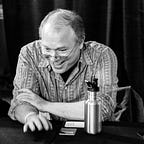Reading the Reprintings
The Printer’s Side
Book collectors make a big deal about first editions. Often, their interest is not just the first time a work appears in print, but rather the first printing of that work, too — a so-called first-first. It would be more accurate to call it the earliest edition, perhaps.
I’m not sure why there’s something so fetishized about it. The first edition taken as a whole may have the loveliest cover, the best binding, the most care taken with it, compared with later settings and printings, which are often produced more cheaply in paperback or by publishers who license the work for reprinting.
But the first printing is the initial impression of type for that edition of work onto paper, and it takes until subsequent printings for typos and other errors to be fixed — although others are routinely introduced. For a popular book that goes quickly back on press, it might require several subsequent ones to get a perfected edition.
An author or publisher may have rushed the first printing of the first edition out, too, eager to start collecting money, or to make good on the crowdfunding campaigns of past centuries, where subscribers paid in advance for books or parts of books, and were sometimes literally banging on the doors to get what’s owed them. Do we think Gutenberg’s very first Bible pages were as good as…
